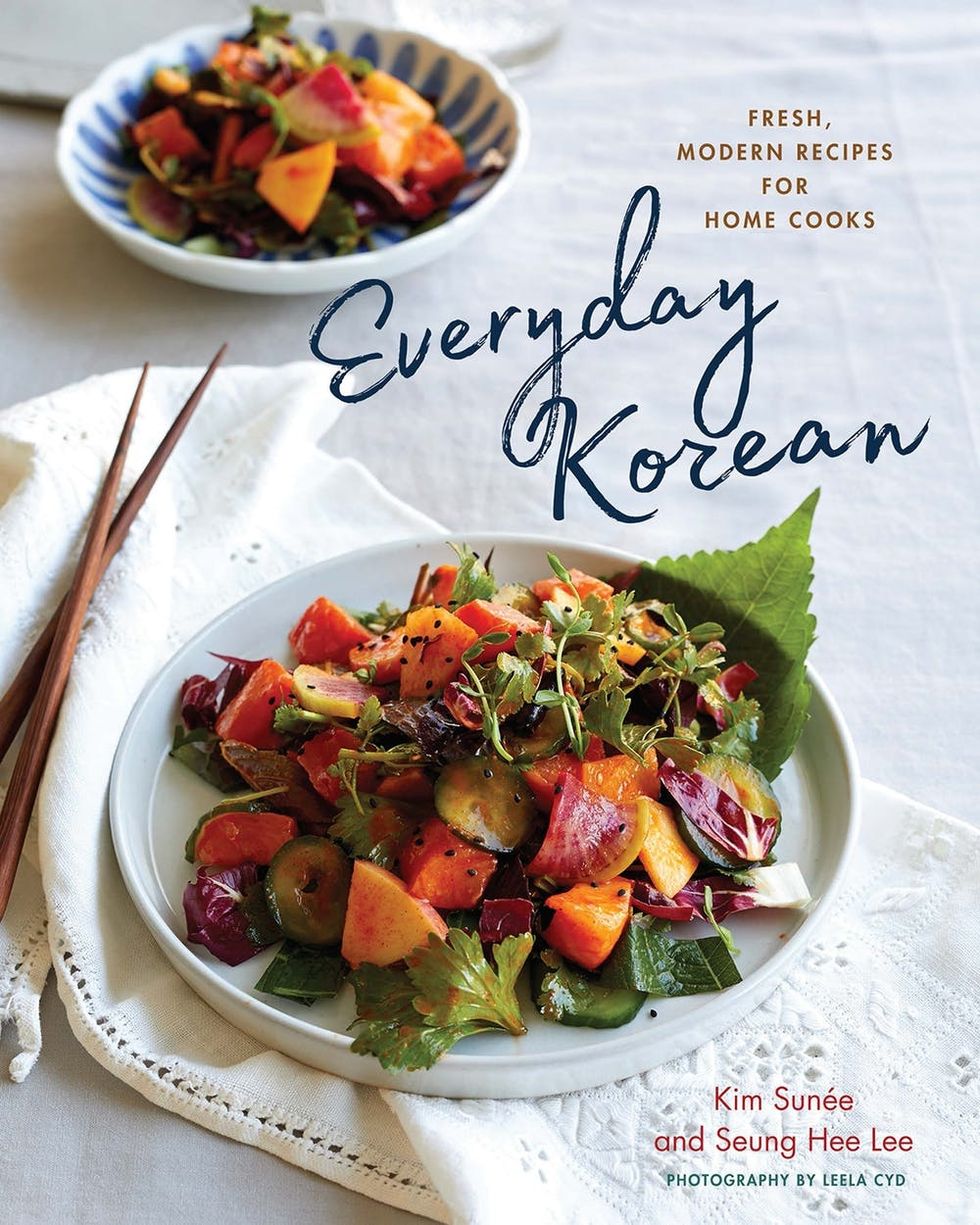The traditional flavors of Korean barbecue translated into an easy-to-make dish.
Here’s Korean Barbecue for the Home Cook: Beef Bulgogi Meatballs

Beef bulgogi meatballs take the traditional flavors of a famous Korean dish and translate them into an easy, recreate-able form — meatballs — for home cooks. “Bulgogi, one of Korea’s most popular beef dishes made of very thin slices marinated and then grilled at a very hot tableside grill, is often served in restaurants. At home, getting the thin bits of beef crispy is hard to mimic and often results in overcooked and anemic-looking meat,” explain authors Kim Sunée and Seung Hee Lee in their cookbook Everyday Korean. “[S]o we took the flavors of bulgogi and made mini meatballs for sliders or to top rice bowls.” Whatever you do, don’t miss out on the saucy condiments. These bulgogi meatballs beg to be drenched in the savory, sweet stuff.

Beef Bulgogi Meatballs
Excerpted from Everyday Korean by Kim Sunée and Seung Hee Lee. Copyright © 2017. Used with permission of the publisher, Countryman Press. All rights reserved.
(Makes 18 slider patties or 40 to 50 mini meatballs)
Ingredients:
- 1⁄4 cup low-sodium soy sauce
- 2 teaspoons fish sauce
- 3 Tablespoons dark brown sugar
- 1⁄4 Asian pear, or Bosc or Bartlett pear, grated
- 2 Tablespoons minced garlic
- 3 Tablespoons minced green onion
- 3⁄4 teaspoon freshly ground black pepper
- 2 Tablespoons toasted sesame oil
- 1 large egg, lightly beaten
- 1⁄3 cup homemade dried breadcrumbs or panko
- 1 pound ground beef, preferably chuck and short rib
- 1 pound ground pork or veal
- neutral oil, such as canola or grapeseed, for panfrying (optional)
- 8 small slider buns, such as brioche or sesame buns, or lettuce leaves and steamed rice
- optional toppings: cheddar, mayonnaise, mustard, Ssamjang (see below), Soy-Vinegar Dipping Sauce (see below)
Instructions:
- Combine the soy sauce, fish sauce, brown sugar, pear, garlic, green onion, black pepper, and sesame oil in a large bowl; whisk well. Add the egg, breadcrumbs, and ground meats and mix just to combine all the ingredients, being careful not to overmix. Cover and let chill in the refrigerator for 30 minutes and up to 2 hours.
- Preheat the oven to 425°F. Form the meat mixture into about 18 slider patties or 40 to 50 mini meatballs and place on a baking sheet. Bake the patties or meatballs until golden and cooked through but still tender and moist, 18 to 20 minutes, turning the pan halfway through cooking time to ensure even cooking. Alternatively, heat about 1 tablespoon of neutral oil in a large pan over medium-high heat. Add the patties or meatballs, being careful not to overcrowd the pan. Cook, shaking the pan occasionally, until the meat starts to brown on one side, about 3 minutes. Gently turn and cook for another 3 to 4 minutes, or until the meatballs are just cooked through and still tender.
- If making sliders and adding cheese, top the patties with cheese about 2 minutes before the cooking time is over. Toast the slider buns and top with the patties and extra pan sauce and your favorite toppings. Meatballs can be served with lettuce leaves and rice, or on top of rice bowls.

Ssamjang
Author notes: Ssam is Korean for “wrap” and jang, for “sauce”; ssamjang is a must-have accompaniment if you are making lettuce or perilla wraps for such dishes as Steamed Pork Vegetable Wraps (page 168) or LA-Style Kalbi (page 154). It’s also a nice dipping sauce for raw vegetables. As with many sauces, balance is important. Here, we use doenjang, gochujang, and sesame oil in a 4:2:1 ratio. Anything else can be adjusted to your taste. We particularly like throwing in some walnuts, which adds texture and extra nuttiness.
(Makes about 1 cup)
Ingredients:
- 1⁄2 cup doenjang or miso
- 1⁄4 cup gochujang
- 2 tablespoons sesame oil
- 1 Tablespoon light corn syrup or granulated sugar
- 1 Tablespoon rice vinegar or cider vinegar
- 1 Tablespoon minced garlic
- 1 Tablespoon minced green onion, white parts only
- 1 Tablespoon minced green chile, such as jalapeño or serrano, stems and seeds removed, or walnuts (optional)
Instructions:
- Place all the ingredients in a small bowl; stir to combine. Can be stored, in an airtight container, in the refrigerator for up to 2 weeks. Gochujang and doenjang absorb liquid, so the sauce may thicken over time; simply stir in some warm water or fresh lemon juice to thin it out.
Soy-Vinegar Dipping Sauce (Cho-ganjang)
Author notes: This is a classic dipping sauce to accompany and brighten up a wide range of dishes, such as jeon (pancakes) and grilled fish. We always use soy and vinegar in a 1:1 ratio for this sauce. Anything else, such as sugar, green onion, or gochugaru, is a bonus and can be adjusted to your taste.
Variation: Quick and easy version: Combine soy sauce with balsamic vinegar in a 1:1 ratio.
(Makes 1⁄2 cup)
Ingredients:
- 1⁄4 cup low-sodium soy sauce
- 1⁄4 cup rice vinegar or cider vinegar
- 1 Tablespoon granulated sugar
- 1 Tablespoon finely chopped green onion
- 1 teaspoon gochugaru (optional)
- 1 teaspoon toasted sesame oil (optional)
- optional garnish: toasted sesame seeds
Instructions:
- Place the soy sauce, vinegar, and sugar in a medium-size bowl; stir to combine. Add any optional ingredients, if desired, sprinkling with toasted sesame seeds just before serving. Serve in a bowl with a small spoon for easy serving, or in individual sauce bowls and use as needed. Can be stored, preferably without the sesame seeds, in an airtight container in the refrigerator for up to 3 days.
You’ll find even more mouthwatering recipes like this one on Brit + Co’s Pinterest page.
Brit + Co may at times use affiliate links to promote products sold by others, but always offers genuine editorial recommendations.
(Photos via Leela Cyd)


















